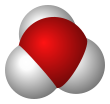Asam iodida
| |||
| |||
| Nama | |||
|---|---|---|---|
| Nama IUPAC
Iodana[1]
| |||
| Nama lain
Hidronium iodida
| |||
| Penanda | |||
Model 3D (JSmol)
|
|||
| 3DMet | {{{3DMet}}} | ||
| ChEBI | |||
| ChemSpider | |||
| Nomor EC | |||
PubChem CID
|
|||
| Nomor RTECS | {{{value}}} | ||
| UNII | |||
| |||
| |||
| Sifat | |||
| HI(aq) | |||
| Massa molar | 127,91 g/mol | ||
| Penampilan | cairan tak berwarna | ||
| Bau | tajam | ||
| Densitas | 1,70 g/mL, azeotrop (57% HI menurut beratnya) | ||
| Titik didih | 127 °C (261 °F; 400 K) 1,03 bar, azeotrop | ||
| Larutan berair | |||
| Keasaman (pKa) | -9,3 | ||
| Bahaya | |||
| Piktogram GHS | 
| ||
| Keterangan bahaya GHS | {{{value}}} | ||
| H314 | |||
| P260, P264, P280, P301+330+331, P303+361+353, P304+340, P305+351+338, P310, P321, P363, P405, P501 | |||
| Titik nyala | Tidak mudah terbakar | ||
| Senyawa terkait | |||
Anion lain
|
Asam fluorida Asam klorida Asam bromida | ||
Senyawa terkait
|
Hidrogen iodida | ||
Kecuali dinyatakan lain, data di atas berlaku pada suhu dan tekanan standar (25 °C [77 °F], 100 kPa). | |||
| Referensi | |||
Asam iodida adalah larutan berair dari hidrogen iodida (HI). Ia adalah sebuah asam kuat, yaitu asam yang terionisasi sepenuhnya dalam larutan berair. Ia tidak memiliki warna. Larutan pekat biasanya mengandung 48% hingga 57% HI.[2]

Reaksi
[sunting | sunting sumber]Asam iodida akan bereaksi dengan oksigen di udara menghasilkan iodin:
- 4 HI + O2 → 2 H2O + 2 I2
Seperti hidrogen halida lainnya, asam iodida menambah alkena untuk menghasilkan alkil iodida. Ia juga dapat digunakan sebagai agen pereduksi, misalnya dalam reduksi senyawa nitro aromatik menjadi anilin.[3]
Proses Cativa
[sunting | sunting sumber]Proses Cativa adalah penggunaan akhir utama dari asam iodida, yang berfungsi sebagai ko-katalis untuk produksi asam asetat melalui karbonilasi metanol.[4][5]

Penggunaan terlarang
[sunting | sunting sumber]Asam iodida terdaftar sebagai Bahan Kimia Daftar I DEA Federal A.S., karena penggunaannya sebagai agen pereduksi terkait dengan produksi metamfetamina dari efedrina atau pseudoefedrina (dipulihkan dari pil dekongestan hidung).[6]
Referensi
[sunting | sunting sumber]- ^ Henri A. Favre; Warren H. Powell, ed. (2014). Nomenclature of Organic Chemistry: IUPAC Recommendations and Preferred Names 2013. Cambridge: The Royal Society of Chemistry. hlm. 131.
- ^ Lyday, Phyllis A. (2005), "Iodine and Iodine Compounds", Ullmann's Encyclopedia of Industrial Chemistry, Weinheim: Wiley-VCH, hlm. 382–390, doi:10.1002/14356007.a14_381
- ^ Kumar, J. S. Dileep; Ho, ManKit M.; Toyokuni, Tatsushi (2001). "Simple and chemoselective reduction of aromatic nitro compounds to aromatic amines: reduction with hydriodic acid revisited". Tetrahedron Letters. 42 (33): 5601–5603. doi:10.1016/s0040-4039(01)01083-8.
- ^ Jones, J. H. (2000). "The Cativa Process for the Manufacture of Acetic Acid" (PDF). Platinum Metals Rev. 44 (3): 94–105. Diarsipkan dari versi asli (PDF) tanggal 2015-09-24. Diakses tanggal 2023-07-07.
- ^ Sunley, G. J.; Watson, D. J. (2000). "High productivity methanol carbonylation catalysis using iridium - The Cativa process for the manufacture of acetic acid". Catalysis Today. 58 (4): 293–307. doi:10.1016/S0920-5861(00)00263-7.
- ^ Skinner, Harry F. (1990). "Methamphetamine synthesis via hydriodic acid/Red phosphorus reduction of ephedrine". Forensic Science International. 48 (2): 123–134. doi:10.1016/0379-0738(90)90104-7.
Pranala luar
[sunting | sunting sumber]- (Inggris) International Chemical Safety Card 1326
- (Inggris) European Chemicals Bureau




